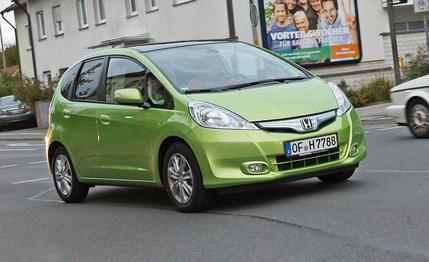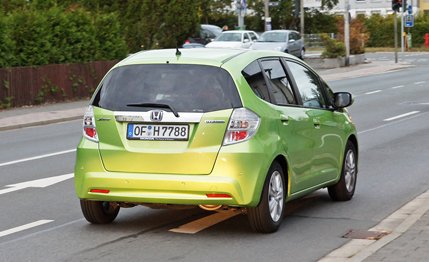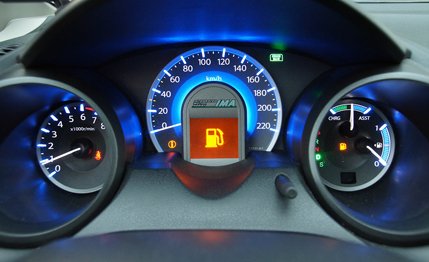 First Drive Review
First Drive Review
The 10Best-winning Honda Fit is one of the best minicars available: agile, spacious, and equipped with a spunky and efficient powertrain. At the Los Angeles auto show, Honda one-upped itself in efficiency with the Fit EV, which trades the regular Fit’s 117-hp four-cylinder for a 134-hp electric motor making 189 lb-ft of torque. Sure, it burns no local fuel, but it’s pricey—about $14,000 for a three-year lease, and then you have to give it back—and will only manage 75 or so miles on a charge. In Japan and Europe, Honda also produces the missing link between these two Fits. The hybrid has been available in Japan since 2010 and in Europe, where the Fit is known as the Jazz, since 2011.
Hybrid tech is an expensive way to reduce fuel consumption, and is particularly frightening in such a small, otherwise affordable car. The benefit, however, is pronounced. In the European combined cycle, which we’ll use for comparative purposes, the tiny Honda manages 44 mpg with its entry-level engine, an 89-hp, 1.2-liter four. With an 87-hp, 1.3-liter four assisted by a 14-hp electric motor, the hybrid gets 52 mpg, an increase of nearly 20 percent. And unlike many wildly optimistic Euro-cycle ratings, that one is actually attainable in real life—although it requires plenty of thinking ahead and lots of acting like a roadblock.
Un-Honda and Un-Prius
Like most hybrids, the Fit can use its gas engine and electric motor separately or together. Electric-only operation is a rare occurrence with Honda’s Integrated Motor Assist system and nearly impossible above 30 mph. Even climbing slight grades or under modest acceleration, the gas engine jumps in. And no matter how lightly you press the accelerator, the Fit never takes off in electric mode. When the electric motor engages or disengages, you occasionally feel a very slight—but very un-Honda—jolt.

Although it doesn’t have an EV button like that in a Prius—not that the Toyota’s button does much—the Fit hybrid does have an “econ” button that activates what Honda calls “super economy mode.” In this mode, it’s possible to get close to—or even exceed—the European fuel-economy ratings, but the car’s responses slow so much that it turns into an almost stationary appliance. We tried economy mode once and then pretended the button didn’t exist.
Scream at Me Until My Ears Bleed
In regular driving, the hybrid feels alive and quick. But when you really need to move, the combination of small four-banger and CVT means nothing happens too quickly. That’s not entirely true. The engine does start howling immediately, but it manages only moderate acceleration. The transmission has an S mode, but we’re not convinced that’s an S as in “sport.” In it, the CVT lets the engine rev more, but there’s not a notable difference in acceleration. It’s best to keep the Fit hybrid in its regular transmission mode and go with the traffic flow.
You’re not really capable of going much faster than traffic, anyway. The Fit hybrid is a somewhat phlegmatic little car. It needs nearly 11 seconds to get to 60 mph, or about 2.5 seconds more than the Fit we get here. Top speed is supposedly around 110, but you’d probably tire of hearing the 1.3-liter scream at redline long before triple digits. At 2750 pounds, the hybrid carries an extra 200 or so pounds compared with the regular car, and there is no mistaking its heft in quick corners. It lacks the agility of its conventionally powered siblings and possesses none of their tossability at the limit, instead plowing wide at high cornering speeds.

Not surprisingly, the most-fuel-efficient Fit—at least until the EV arrives—is also the most expensive. In Germany, the hybrid costs nearly 50 percent more than the cheapest gas-fired Fit. An expensive Fit is still pretty affordable, but given the trade-offs in performance and fun, we’re not interested. It may be the missing link between the internal-combustion engine and the electric car, but it wouldn’t be missed.